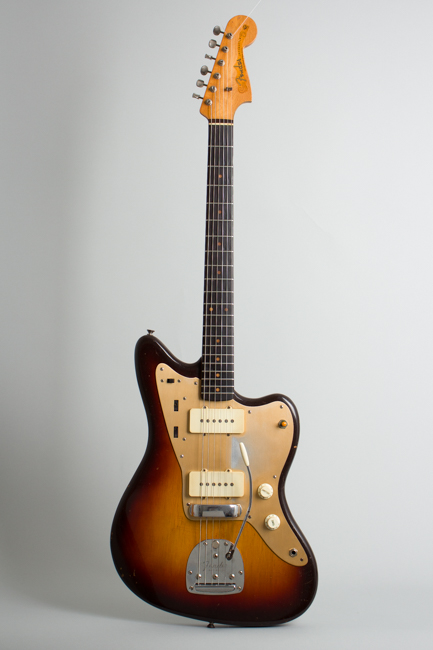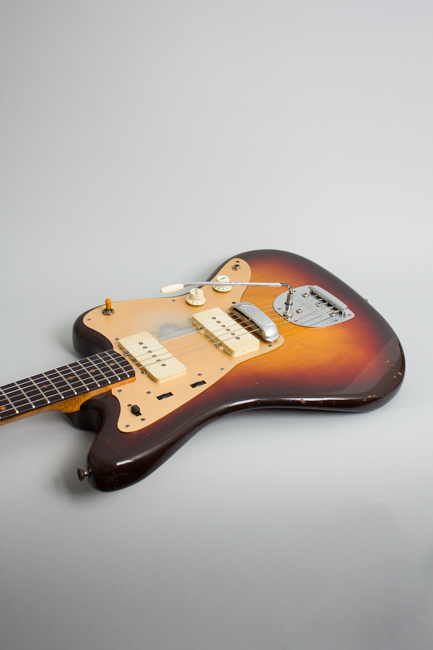Fender Jazzmaster Solid Body Electric Guitar (1959)
This item has been sold.
Item # 12270
Prices subject to change without notice.
Fender Jazzmaster Model Solid Body Electric Guitar (1959), made in Fullerton, California, serial # 32734, sunburst lacquer finish, alder body, maple neck with rosewood fingerboard, original tweed hard shell case.
This is a lovely, played but well cared for Fender Jazzmaster, one of the earliest we have seen. It carries a beautiful deep 3-color sunburst set off by the classic gold anodized pickguard that marks the first versions of the model. This then brand new instrument was Fender's showpiece instrument, their upscale top of the line prestige offering introduced in fall 1959 at $329.50, plus case. The Fullerton factory lavished a maximum of care and effort on early Jazzmaster production; we find these first generation "offsets" to nearly always be exceptionally fine instruments.
This guitar's neck is pencil dated 1-59 on the heel (January 1959) only a few months after Jazzmaster production commenced in the fall of '58. The visible pot dates are 8-50 (December 1958); there is no body date evident. The guitar was most likely assembled and shipped early in 1959. The striking looking anodized pickguard proved unfortunately prone to pick wear and was replaced with the familiar tortoise celluloid piece by late summer '59; the early models carrying it are exponentially rarer than their 1960s descendants.
When this guitar was made the Jazzmaster was a brand new, completely unique concept and a bold step into the future for Fender. Novel features including the patented liquid sculpture "offset" body with a staggered waist, dual rhythm/lead circuit wiring, floating bridge and tremolo and the wider-coil pickups; all fresh ground for Fender. The thick "slab" rosewood fingerboard with clay dots was introduced with this model, and soon became ubiquitous across the entire Fender line replacing the earlier one-piece maple neck.
Leo's concept for the instrument was to appeal to the "sit-down" jazz players mostly loyal to hollowbody guitars; the design was bold and brilliant but failed to entice dedicated Gibson players to embrace Fender products. Still the Jazzmaster was quite successful in other genres from the start, and remained popular into the mid 1960s before losing ground as playing styles changed at the end of the decade.
Over the last 25 years or so the Jazzmaster, once maligned, has caught the fancy of new generations of players and risen to be one of the most widely played and copied of all vintage designs. This wonderful early example has been well used but never altered and remains an exceptional-sounding and extremely attractive twang machine. This guitar has a great feel and a lovely "ring" to it, even when not plugged in. Jazzmasters simply do not come too much better than this.
Overall length is 41 in. (104.1 cm.), 14 in. (35.6 cm.) wide at lower bout, and 1 5/8 in. (4.1 cm.) in depth, measured at side of rim. Scale length is 25 1/2 in. (648 mm.). Width of nut is 1 5/8 in. (41 mm.).
This Jazzmaster shows some general wear overall but remains all original and unaltered; it appears played for some time but well cared for. The original deep and rich 3-tone sunburst lacquer finish on the body has some fade but retains more red hue than many; some from this period appear faded to two-tone by now. There is some light checking and a collection of dings, dents, and scrapes overall but the only large area of loss is a large swath of belt buckle wear to the back. The anodized pickguard has a typical spot of wear below the strings down to the bare metal; the gold finish on the rest of the surface remains intact.
The neck shows some noticeable wear on the treble side edge, where someone played it enough to wear softly into the wood just above the second and fourth frets. This is feelable when playing but not distracting. There is light divoting to the fingerboard in the same region. The finish is worn off the edges of the board but still largely intact along the center with some small dings and dents. The headstock finish has been "smoked" and darkened a bit but retains a nicely intact decal.
All hardware inside and out appears original and intact, even the oft-missing trem arm and snap-on bridge cover are present. The guitar was unsurprisingly refretted along the way, with wire just slightly taller than the original but not oversize. This very fine first-generation Jazzmaster; an effortless player and while it has seen some serious use over the last 65 years as a whole it has survived very well with its distinctive sound and character fully intact, still housed in a very nice original tweed HSC. Overall Very Good + Condition.
This is a lovely, played but well cared for Fender Jazzmaster, one of the earliest we have seen. It carries a beautiful deep 3-color sunburst set off by the classic gold anodized pickguard that marks the first versions of the model. This then brand new instrument was Fender's showpiece instrument, their upscale top of the line prestige offering introduced in fall 1959 at $329.50, plus case. The Fullerton factory lavished a maximum of care and effort on early Jazzmaster production; we find these first generation "offsets" to nearly always be exceptionally fine instruments.
This guitar's neck is pencil dated 1-59 on the heel (January 1959) only a few months after Jazzmaster production commenced in the fall of '58. The visible pot dates are 8-50 (December 1958); there is no body date evident. The guitar was most likely assembled and shipped early in 1959. The striking looking anodized pickguard proved unfortunately prone to pick wear and was replaced with the familiar tortoise celluloid piece by late summer '59; the early models carrying it are exponentially rarer than their 1960s descendants.
When this guitar was made the Jazzmaster was a brand new, completely unique concept and a bold step into the future for Fender. Novel features including the patented liquid sculpture "offset" body with a staggered waist, dual rhythm/lead circuit wiring, floating bridge and tremolo and the wider-coil pickups; all fresh ground for Fender. The thick "slab" rosewood fingerboard with clay dots was introduced with this model, and soon became ubiquitous across the entire Fender line replacing the earlier one-piece maple neck.
Leo's concept for the instrument was to appeal to the "sit-down" jazz players mostly loyal to hollowbody guitars; the design was bold and brilliant but failed to entice dedicated Gibson players to embrace Fender products. Still the Jazzmaster was quite successful in other genres from the start, and remained popular into the mid 1960s before losing ground as playing styles changed at the end of the decade.
Over the last 25 years or so the Jazzmaster, once maligned, has caught the fancy of new generations of players and risen to be one of the most widely played and copied of all vintage designs. This wonderful early example has been well used but never altered and remains an exceptional-sounding and extremely attractive twang machine. This guitar has a great feel and a lovely "ring" to it, even when not plugged in. Jazzmasters simply do not come too much better than this.
Overall length is 41 in. (104.1 cm.), 14 in. (35.6 cm.) wide at lower bout, and 1 5/8 in. (4.1 cm.) in depth, measured at side of rim. Scale length is 25 1/2 in. (648 mm.). Width of nut is 1 5/8 in. (41 mm.).
This Jazzmaster shows some general wear overall but remains all original and unaltered; it appears played for some time but well cared for. The original deep and rich 3-tone sunburst lacquer finish on the body has some fade but retains more red hue than many; some from this period appear faded to two-tone by now. There is some light checking and a collection of dings, dents, and scrapes overall but the only large area of loss is a large swath of belt buckle wear to the back. The anodized pickguard has a typical spot of wear below the strings down to the bare metal; the gold finish on the rest of the surface remains intact.
The neck shows some noticeable wear on the treble side edge, where someone played it enough to wear softly into the wood just above the second and fourth frets. This is feelable when playing but not distracting. There is light divoting to the fingerboard in the same region. The finish is worn off the edges of the board but still largely intact along the center with some small dings and dents. The headstock finish has been "smoked" and darkened a bit but retains a nicely intact decal.
All hardware inside and out appears original and intact, even the oft-missing trem arm and snap-on bridge cover are present. The guitar was unsurprisingly refretted along the way, with wire just slightly taller than the original but not oversize. This very fine first-generation Jazzmaster; an effortless player and while it has seen some serious use over the last 65 years as a whole it has survived very well with its distinctive sound and character fully intact, still housed in a very nice original tweed HSC. Overall Very Good + Condition.












